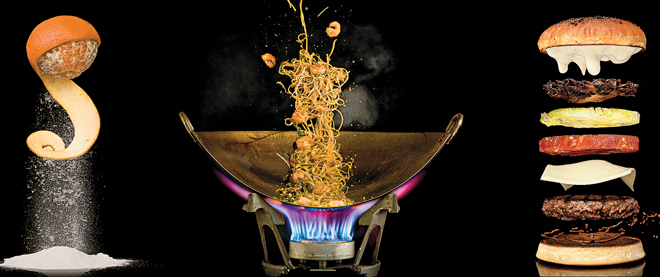The definitive ($600) cookbook
2,438 pages, 47.3 lb., housed in Plexiglas, ‘it will influence food for years to come’
Culinary splendour: The six-volume cookbook is a visual delight to pore through. Recipes from famed chefs are printed on water- and tear-proof pages.
Share

Alison Fryer, the manager of Toronto’s Cookbook Store, recalls how anxious she was ordering 10 copies of Modernist Cuisine before its publication in late March. “We didn’t know if we would sell them,” she says. Her concern was reasonable: with a $600 price tag, the six-volume set is the most expensive newly published food book in history. Fryer needn’t have worried: the store has sold 35 copies; now she’s fretting about filling demand. “I can’t get them fast enough,” she says, standing amid a new shipment of boxes containing the 2,438-page, 47.3-lb. set housed in a Plexiglas box. The audience for the authoritative reference is diverse—“chefs, food scientists, people who travel for food, people who like to know what chefs are thinking.” Last week, a culinary college in Nebraska desperately called in search of a copy. Currently in its third printing, it’s sold out in the U.S. Fryer now has a new anxiety, she jokes: “People are blaming us for putting their backs out.”
It’s the latest status injury. Modernist Cuisine, self-published by Nathan Myhrvold, abetted by the fortune he amassed in his 14 years at Microsoft, has been heralded as a culinary landmark. In the forward, Spanish chef and food wizard Ferran Adrià praises it as “a stepping stone to the future of cooking” and “a book that raises expectations of what cooking can be.”
The volumes, a visual delight to pore through, are classified by subject: history and fundamentals; techniques and equipment; animals and plants; ingredients and preparations; plated dish recipes; and a spiral-bound “kitchen manual” with recipes from famed chefs cleverly printed on water- and tear-proof pages. Throughout, Myhrvold and co-authors Chris Young and Maxime Bilet detonate culinary orthodoxies with creative gusto: wine can be successfully aerated in the blender, they claim; a one-hour stock made in a pressure cooker is as flavourful as the eight-hour version; it doesn’t damage steak to flip it on the grill repeatedly; there’s no definitive proof that eating fibre reduces the risk of colon cancer. While centrifuges and freeze-dryers are routinely employed to create novelties such as “meat jerky” from watermelon and carrot foam, those lacking the gizmos will find a font of information—from insights about nutrition and food safety to a whimsical version of the Colonel’s secret KFC recipe.
Research was conducted in Myhrvold’s Willy Wonkaesque food lab in a Seattle suburb. The genius polymath, who now runs a company devoted to developing world-changing ideas (one to curb global warming involves suspending sulphur-dioxide-emitting hoses above the Earth to dim the sun imperceptibly) is also a master French chef who has won Memphis’s world barbecue championship. In 2006, he started writing an exploration of sous vide, the techique of cooking food sealed in an airtight plastic bag. In 2009, co-authors Young and Bilet came on board. “It was a shell of a project,” says Bilet, a chef who’d worked with Young at Heston Blumenthal’s Fat Duck in England. “It took on its own life.” Bilet was skeptical of the high-tech approach at the outset, he says, but experimentation shifted his perspective: “I had much greater creativity when I understood the science.”
The omelette became a focal point of research. “Every degree above 60° C creates a different texture of egg,” Bilet says. After hundreds of trials they created an omelette filled with scrambled eggs and mushroom marmalade. The texture was perfect, he says. “Then Nathan wanted to take it to the next level using a technique from French cake-making,” using dehydrated eggs. The resulting mushroom omelette (Vol. 5, page 215) was a breakthrough, says Bilet. “It was very dramatic visually but had all of the flavour. It was classic and modern.”
For chefs like Nick auf der Mauer of Toronto’s Porchetta & Co., Modernist Cuisine offers the ultimate reference. “I had to have it,” he says. “It’s a complete document of modern cooking. I’m not a molecular gastronomy guy. I make sandwiches. But it will influence food for years to come.” He hasn’t found time to dip into it yet, he admits. “But right now it’s a great doorstop.”
Myhrvold’s secret recipe
The perfect omelette (or scrambled eggs) ratio: for optimum texture and flavour, Myhrvold uses three egg yolks and two egg whites cooked at 165° F in a steam oven.